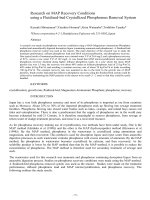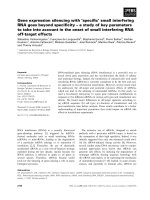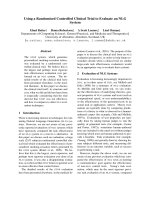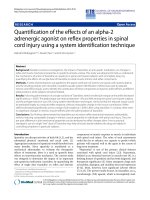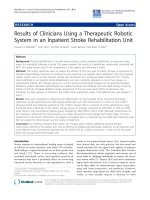Using a delayed coincidence counting system to determine 223Ra, 224Ra in seawater sample
Bạn đang xem bản rút gọn của tài liệu. Xem và tải ngay bản đầy đủ của tài liệu tại đây (335.4 KB, 7 trang )
Nuclear Science and Technology, Vol.8, No. 3 (2018), pp. 29-35
Using a delayed coincidence counting system to determine
223
Ra, 224Ra in seawater sample
Vo Thi Mong Tham, Phan Son Hai, Nguyen Van Phuc, Nguyen Minh Dao,
Phan Quang Trung, Le Xuan Thang, Nguyen Thi Huong Lan
Nuclear Research Institute, 01 Nguyen Tu Luc Street, Dalat, Vietnam
Email:
(Received 03 January 2018, accepted 20 November 2018)
Abstract: A Radium Delayed Coincidence Counter (RaDeCC) includes 3 channels (223Ra channel,
224
Ra channel, and total channel). It has been newly designed and assembled at Nuclear Research
Institute. To determine 223Ra and 224Ra in seawater samples, the system efficiency at all 3 channels
were investigated and calibrated. The research results showed that the RaDeCC operates stably and
reliably with high efficiency of 26%. In this project, a procedure for measuring short half-life radium
isotopes was established with a low detection limit (LOD ( 223Ra) = 0.002 Bq; LOD (224Ra) = 0.01 Bq),
good reproducibility, and high precision. The technique is suitable for qualitative analysis of 223Ra,
224
Ra in seawater samples at low concentration. The 11 coastal water samples were collected in a
coastal of Ninh Thuan province. The analytical data of short-lived radium isotopes concentration in
seawater at Ninh Thuan coastal area are 11.2 × 10-3 ÷ 45.5 × 10-3 mBq/L for 223Ra, and 34.7 × 10-2 ÷
21.9 × 10-1 mBq/L for 224Ra.
Keywords: Radium Delayed Coincidence Counter,
calibration, limit of detection.
I. INTRODUCTION
Natural radium isotopes have been used
very effectively to study the dynamic
parameters of coastal waters such as residence
time, oceanic processes, vertical and horizontal
diffusion coefficients, process of mixing
groundwater with seawater, etc. [1-6]. Radium
isotopes are proved to be ideal tracers for
quantifying fluxes of dissolved components
across the continental shelf (Moore, 2000).
Radium isotopes have been applied to study
residence time of coastal water, mixing factors
of coastal water with ocean (Bourquin, M. et
al., 2008; Beek P. van et al., 2008; Moore W.S.
et al., 2008; Rapaglia J. et al., 2010; Souza
T.A. et al., 2010; HequanGu et al., 2012). 226Ra
and 228Ra are suitable for studies in regional
level owing to their long half-lives. Short-lived
nuclides 223Ra (T1/2 = 11.44 d) and 224Ra (T1/2 =
3.66 d) are appropriate for the investigation of
223
Ra and
224
Ra, seawater samples, efficiency
the submarine groundwater discharge and its
pathway [1-7].
There are some techniques for
analyzing radium isotopes such as Alpha
spectrometry, Gamma spectrometry, Liquid
Scintillation Counting, Inductively Coupled
Plasma-mass
Spectrometry,
Thermal
Ionisation
Mass
Spectrometry,
and
Accelerator
Mass
Spectrometry,
etc.
However, analysis of 223Ra and 224Ra
radioactive in sea water is difficult due to the
following reasons: (i) Activities of 223Ra and
224
Ra in seawater samples is very low (e.g. 0.5
÷ 5.0 mBq/L); (ii) The half-lives of 2 radium
isotopes are very short, so all current
analytical methods require pre-enrichment and
radium separation to eliminate disturbance
factors [4, 8-10].
A newly analytical technique has been
developed to quickly and easily identify 223Ra
©2018 Vietnam Atomic Energy Society and Vietnam Atomic Energy Institute
USING A DELAYED COINCIDENCE COUNTING SYSTEM TO DETERMINE 223Ra, 224Ra…
and 224Ra radionuclides in seawater by radium
delayed coincidence counter system [3]. This
technique was successfully applied by many
research groups around the world [7-8, 10-13].
Mn-fiber. The principle of the method is based
on the measurement of alpha radiation,
produced by radioactive decay of the Ra
daughter, Rn, in a scintillation (or Lucas) cell
coated in the inside with silver-activated ZnS.
When an alpha particle collides with the ZnS
surface, it produces a light signal which is
detected by a photomultiplier tube which
translates the photon into an electrical count.
Rn produced by the decay of Ra on the Mnfiber is transported to a scintillation cell where
it decays to Po. As alpha decay of Rn occurs, it
produces an electronic signal which opens the
gate to a delayed coincidence circuit. The
counts are displayed on a computer by
Labview [10, 12].
This study is aimed at: (i) Calculating the
efficiency of RaDeCC, calibrating the
efficiencies at 3 channels; (ii) Establishing the
limit of detection with good reproducibility, and
high precision; (iii) Establishing the procedure
for analyzing shorted-lived radium isotopes in
seawater samples; (iv) Applying this technique
to an in-situ research at Ninh Thuan coastal area
to evaluate the ability of the method.
II. EXPERIMENTS
A. Theory of RaDeCC
A closed circulation system to pump radon
to the detector is described in Fig. 1. It consists of
(1) a pump with 0-14 L/min flow rate; (2) flow
rate meter; (3) cartridge, filled with Mn-fiber; (4)
compressed helium tank; and (5) alpha detector.
Radium in seawater is adsorbed on a
cartridge filled with MnO2 fiber (called Mnfiber). The RaDeCC system monitors alpha
decays of short-lived Rn which recoil from the
Fig. 1. Schematic diagram of radon circulation system [10].
Prior each measurement, Helium gas
was pumped into the chamber to carry radon
close to detector. In this chamber, the delayed
coincidence signals generated by the decay of
these radon isotopes (220Rn, 219Rn) to a shortlived polonium isotope (216Po, 215Po) are
measured.
B. Method of experiment
In the project, Manganese dioxide
impregnated acrylic fiber (Mn-fiber) was
prepared for pre-concentrating radium in
seawater. One gram of this Mn-fiber could
retain 100% of radium and other elements in 8
L of seawater.
30
VO THI MONG THAM et al.
Notes:
(1) Air pump has flow rate of 7 L /min;
(2) Flow meter to measure airflow from
air pump;
(3) PVC cartridges were filled with 35g
of Mn-fiber (diameter 3.5cm, length
30cm);
(4) Helium gas cylinders with purity of
99.99%;
(5) A cylinder chamber was made of
plexiglass with a volume of 1.6 L;
photomultiplier tube (R877) with an
amplifier of Hamamatsu;
(6) To power supply amplifier and
delay circuit;
(7) Computer has installed the
Labview software.
Fig. 2. RaDeCC system at NRI.
1. Selecting optimal factors for the RaDeCC
3. Investigating
RaDeCC system
Selecting an optimal high voltage: By
investigating the dependence of count rate on
high voltage using standard alpha sources, the
optimal high voltage was chosen.
the
efficiency
of
the
The efficiency of the RaDeCC system
was determined by using 223Ra and 224Ra
standard sources. The 223Ra standard source
was prepared from a 227Ac standard solution
supplied by Eckert & Ziegler Analytics. The
224
Ra standard source was prepared by
digesting standard Thorium ore No.
AMD/Phy/Std-7/76 with (0.360 ± 0.003) %
ThO2 in content.
Choosing an optimal amplification factor:
A suitable amplification factor at which the ratio
of real signal to the noise signal is largest was
selected. The procedures are as follows:
+ Use a piece of dark paper to cover
detector surface and then change the value of
amplification to investigate the variance of a
noise signal.
+ Use a standard alpha source to
investigate the variance of count rate with an
amplification factor. From these data, optimal
amplification factor was determined.
2. Investigating the background of the
RaDeCC system
Helium gas has been pumped into the
chamber. The background of the system was
counted for 12h.
Fig. 3. Picture of the fully assembled cartridges.
31
USING A DELAYED COINCIDENCE COUNTING SYSTEM TO DETERMINE 223Ra, 224Ra…
pumping 300 L of seawater through a cartridge
filled with 35 g of Mn-fiber at the flow rate of
2 ÷ 3 L/min. After that, 5 ÷ 10 L of deionized
water were passed through the cartridge at the
same flow rate to remove salt on the fiber. The
cartridge was then dried by air pump to make
the ratio of water to dry weight fiber reaching
50 ÷ 80%. Short-lived nuclides 223Ra and 224Ra
were measured directly on RaDeCC.
4. Development of analytical method for
223
Ra and 224Ra
- Preparation of standard sources: 223Ra
standard source and 224Ra standard source were
prepared from the 227Ac standard solution and
the standard thorium ore, respectively.
- Sample preparation: 200 ÷ 300 L of
seawater were passed through a cartridge filled
with 35 g of Mn-fiber at flow-rate of 2 ÷ 3 L/min.
Then 10 L of deionized water were continuously
passed through this cartridge at above flow-rate
to remove salt. Fiber in the cartridge was dried by
air flow until the ratio of water to dry weight of
Mn-fiber was about 50 ÷ 80%. Two valves of the
cartridge were closed tightly in order to grow
Radon inside the cartridge and attain radioactive
equilibrium with Ra.
III. RESULTS AND DISCUSSION
High
voltage:
Based
on
the
investigation of variation in counts with high
voltage, the optimal high voltage was selected
to be 1250 V for this system.
Amplification factor: The optimal
amplification factor at which the ratio of real
signal to noise reaches the maximum for this
system signal as follows: Coarse gain = 3; Fine
gain = 6.
- Measurement: To determine 223Ra
and 224Ra, each sample was counted for 4
hours twice. The first measurement and the
second one had been conducted within 1-3
days and 7-17 days since the radon
confinement, respectively.
A. Background
The most advantage of RaDeCC is its
low background. Background measurement
results are significant parameters for
calculating the efficiency of the system. These
data were used for calculating number of
sample's count, correcting the results and
uncertainties. Because it is performed before
every sample count and used for correction of
the results and uncertainties.
- Calculation: 223Ra and 224Ra activities
were calculated based on 219Rn and 220Rn net
count rates of samples and those of standard
that were corrected for chance coincidence
events as well as reciprocal interferences
between 219Rn and 220Rn channels.
-Sensitivity, Accuracy and Repeatability:
These factors were estimated by using
standard sources.
5. Analysis of 223Ra and 224Ra isotopes
Background count rates for 219Rn and
Rn channels were 0.01cpm (Stdev = 0.001)
and 0.13 cpm (Stdev = 0.05), respectively.
- Sample collecting: 11 surface sea water
samples in a coastal of Ninh Thuan province
were collected. Sampling distances are from
1.5 to 15.5 km from shore. Sampling depth was
3 m from sea surface.
- Radium preconcentration and analysis:
Radium in seawater was pre-concentrated by
However, by consecutively measuring
samples in the same counter the subsequent
backgrounds may increase due to decay
products remaining in the counting cell. In
order to clear the system of these residual
isotopes, ambient air is circulated through the
open system for at least 30 mins.
220
32
VO THI MONG THAM et al.
fiber are measured at the same sample
geometry, air flow rate, and optimal factors to
calibrate the RaDeCC's efficiency (Fig. 4).
B. Efficiency
Ra (0.57 ± 0.11 Bq) and 224Ra (1.37 ±
0.01 Bq) standard material adsorbed on Mn-
Efficiency (%)
223
Ra-223
Ra-224
Sample measurements
Fig. 4. Efficiencies of 223Ra, 224Ra channels.
Based on the results from 6 times of
measurements, efficiency of 223Ra changed
from 24.75 to 27.88 percent and from 25.25
percent to 27.18 percent for 224Ra channel.
Mean counting efficiencies (%) at 219Rn
220
and Rn channels were 26.6 ± 2.0 and 26.0 ±
2.3, respectively.
count rates, limit of detection (LOD) was
estimated to be 0.002 Bq for 223Ra and 0.01 Bq
for 224Ra.
In this study, 300L of sea water needed
to be collected to determine 223Ra and 224Ra on
the RaDeCC.
- Accuracy of the method: Results from
analyzing standard samples showed that
analytical values and certified values agreed
to each other in a maximum deviation of
3.5%.
C. Development of an analytical method for
223
Ra and 224Ra:
- Limit of detection: Based on
background count rates and standard sample
Table I. The results of standard analysis (measurement time: 2 400 s).
Activity on the Mn-fiber
standard (dpm)
Deviation (%)
223
35.2 ± 2.4
34.0 ± 6.8
-3.5
224
80.7 ± 7.4
82.1 ± 0.7
1.7
Ra
dpm
Ra
Analysis of 223Ra
dpm
RaDeCC
Analysis (dpm)
Isotopes
Analysis of 223Ra
Series1
Series1
Series1
Series1
Series1
Series1
Series1
, 9,
Series1
6,
, 1, , 2,
, 4, , 5, ,, 8,
7,
33.345
,
3,
31.840
31.590
31.590
31.289
31.214
30.300
30.085
28.581
Sample measurements
Sample measurements
Fig.5. The results of standard measurement.
33
USING A DELAYED COINCIDENCE COUNTING SYSTEM TO DETERMINE 223Ra, 224Ra…
which range from 11.2 × 10 -3 mBq /L to
45.5 × 10 -3 mBq /L for 223 Ra and from 34.7
× 10 -2 mBq /L to 21.9 × 10 -1 mBq /L for
224
Ra, are shown in Table II. In comparisons
with some previous studies, the results of
radium concentration of Ninh Thuan sea are
seem to be in good agreement with the
range of radium concentration at other areas
in the world.
- Repeatability of the method: Results
from repeated analyzing of standard samples
showed that all analytical values were within
95% confidence level of certified value.
D. Concentrations of 223Ra and
isotopes in seawater samples:
224
Ra
The concentrations of short-lived
radium isotopes in Ninh Thuan coastal area,
Table II. A concentration of 223Ra and 224Ra isotopes of 11 seawater samples.
Sample
223
224
Ra (mBq/L)
-3
Ra (mBq/L)
PD_A1
45 × 10 ± 1.8 × 10
-3
218 × 10-2 ± 7 × 10-2
PD_A2
188 × 10-4 ± 3 × 10-4
121 × 10-2 ± 3 × 10-2
PD_A3
272 × 10-4 ± 6 × 10-4
124 × 10-2 ± 3 × 10-2
PD_A4
269 × 10-4 ± 6 × 10-4
119 × 10-2 ± 2 × 10-2
PD_A5
308 × 10-4 ± 8 × 10-4
110 × 10-2 ± 1.4 × 10-2
PD_A6
198 × 10-4 ± 3 × 10-4
103 × 10-2 ± 1.0 × 10-2
PD_A7
329 × 10-4 ± 9 × 10-4
102 × 10-2 ± 1.3 × 10-2
PD_A8
112 × 10-4 ± 1.1 × 10-4
680 × 10-3 ± 4 × 10-3
PD_A9
116 × 10-4 ± 1.2 × 10-4
469 × 10-3 ± 2 × 10-3
PD_A10
164 × 10-4 ± 2 × 10-4
347 × 10-3 ± 1.4 × 10-3
PD_A11
204 × 10-4 ± 4 × 10-4
406 × 10-3 ± 1.2 × 10-3
requirement for rapid analysis of
224
Ra in sea water.
IV. CONCLUSIONS
The project has been completely
implemented and following main results
were achieved:
223
Ra and
- The preliminary results showed that
this new technique is absolutely applicable to
determination of 223Ra and 224Ra at low level in
Vietnam coastal area.
- A procedure for preconcentration and
analysis of short-lived radium isotopes 223Ra
and 224Ra using delayed coincidence counting
system was developed. This procedure is fairly
simple, easy to operate, capable of providing
analytical data in a short time.
REFERENCES
[1]. Beek, P. van et al., “Radium isotopes to
investigate the water mass pathways on the
Kerguelen Plateau (Southern Ocean)”. DeepSea Research II (55), pp. 662-637, 2008.
- The analytical method has high
sensitivity ( 223Ra: 0.002 Bq; 224Ra: 0.01Bq),
accuracy
(uncertainty
<5%),
and
repeatability. This procedure meets the
[2]. Gu, H. et al., “Using radium isotopes to
estimate the residence time and the
contribution of submarine groundwater
34
VO THI MONG THAM et al.
discharge (SGD) in the Changjiang effluent
plume, East China Sea”. Continental Shelf
Research (35), pp. 95-107, 2012.
seawater”. Marine Chemistry 109, pp. 226237, 2008.
[8]. Souza, T.A. et al., “Use of multitracers for the
study of water mixing in the Paraiba do Sul
River estuary”. Journal of Environmental
Radioactivity (101), pp. 564-570, 2010.
[3]. Moore, W.S., “Fifteen years experience in
measuring 224Ra and 223Ra by delayedcoincidence counting”. Marine Chemistry
(109), 188 – 197, 2008.
[9]. Moore. WS., Arnold, R., “Measurement of
223
Ra and 224Ra in coastal waters using a
delayed coincidence counter”. J. Geophys.
Res. (101), 1321-1329, 1996.
[4]. GuogangJia, Jing Jia, “Determination of
radium isotopes in environmental samples by
gamma spectrometry, liquid scintillation
counting and alpha spectrometry: a review of
analytical
methodology”.
Journal
of
Environmental Radioactivity (106), pp. 98119, 2012.
[10]. E. Garcia-Solsona et al., “Uncertainties
associated with 223Ra and 224Ra measurements
in water via a Delayed Coincidence Counter
(RaDeCC)”. Marine Chemistry (109), 198 –
219, 2008.
[5]. Rapaglia, J. et al., “Investigation of residence
time and groundwater flux in Venice Logoon:
Comparing
radium
isotope
and
hydrodynamical
models”.
Journal
of
Environmental Radioactivity (101), pp. 571581, 2010.
[11]. Guebuem Kim, “Measurement and Application
of Radium and Radon in the Environment”.
Journal of Analytical Science & Technology 2
(Supply A), A115-A119, 2011.
[12]. Giffin, C., A. Kaufman, and W. S. Broecker,
“Delayed coincidence counter for the assay of
action and thoron”. J. Geophys.Res., (68),
1749-1757, 1963.
[6]. Souza, T.A. et al., “Use of multitracers for the
study of water mixing in the Paraiba do Sul
River estuary”. Journal of Environmental
Radioactivity (101), pp. 564-570, 2010.
[13]. Moore, W.S., Reid, D.F., “Extraction of
radium from natural waters using manganeseimpregnated acrylic fibers”. J. Geophys.Res.
78 (36), 8880-8885, 1973.
[7]. Bourquin, M. et al., “Comparison of
techniques for pre-concentrating radium from
35


